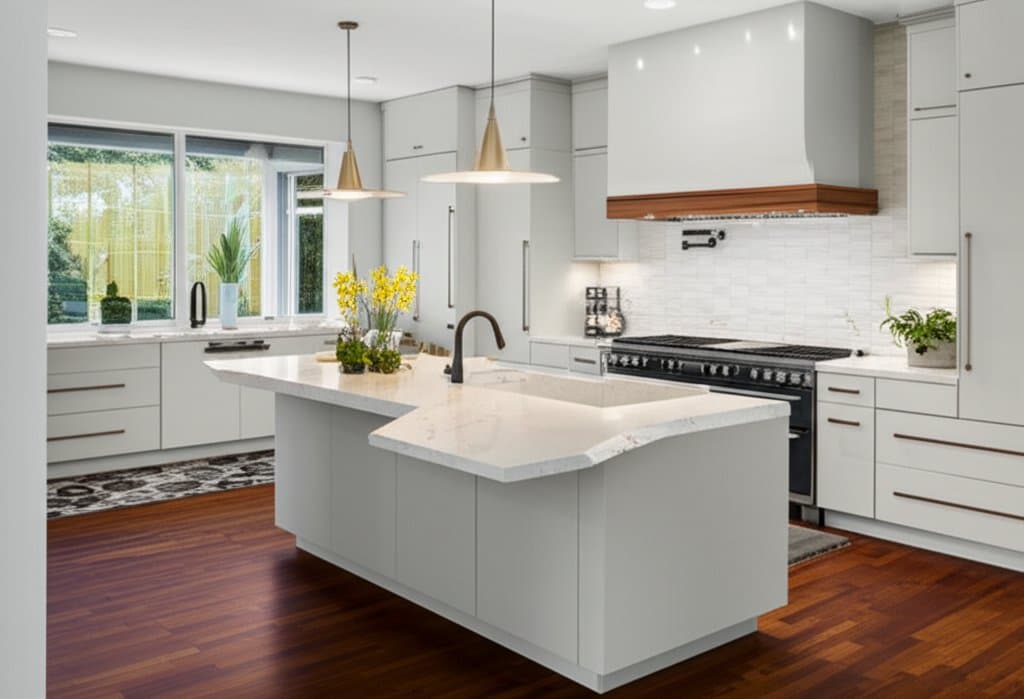Induction Islands: The Key to Safer, Modern All-Electric Kitchens
Have you walked into a showroom lately and noticed those sleek, low-profile kitchen islands with futuristic glass cooktops? If you are considering replacing a gas range or planning a full kitchen remodel, an induction kitchen island offers a practical, stylish, and safe solution. This guide explains what makes induction islands a standout choice, why all-electric kitchens are gaining traction, and how to design a remodel that aligns with your budget and daily needs.
Understanding Induction Kitchen Islands
How Induction Technology Works
Induction cooktops operate using magnetic fields to directly heat the cookware, leaving the glass surface cool except beneath the pan. This results in rapid heating and a significantly reduced risk of burns. To ensure compatibility, your pots and pans must be ferrous, such as cast iron or magnetic stainless steel. A quick test with a magnet will confirm if your cookware is suitable.
Benefits Over Gas and Traditional Electric
Compared to gas or standard electric ranges, induction offers faster boiling and precise temperature control. Without combustion, there are no indoor emissions like nitrogen oxides, leading to cleaner air in your home. The smooth glass surface also simplifies cleanup and enhances the island's aesthetic, transforming it into a striking kitchen centerpiece.
Why Opt for an Induction Island in an All-Electric Kitchen
- Social Connection: An island allows you to face family or guests while cooking, fostering interaction.
- Design Flexibility: Positioning the cooktop away from walls opens up creative options for ventilation and layout.
- Versatile Use: Combine cooking, prep space, seating, and storage within a single, efficient footprint.
Emerging Trends in Kitchen Remodels
Homeowners are increasingly adopting induction technology as electricity grids modernize and building codes discourage indoor gas lines. Many induction cooktops now feature smart connectivity, integrating with apps for remote control and energy monitoring. Designers often pair these islands with sustainable materials and hidden ventilation to maintain an open, uncluttered look. Health concerns, particularly for families with children or respiratory issues, are also pushing the shift to gas-free kitchens.
Step-by-Step Guide to Designing Your Induction Island
1. Plan Size and Workflow
Maintain the classic kitchen work triangle, ensuring distances between sink, refrigerator, and cooktop range from four to nine feet. Allow at least 42 inches of clearance around the island for easy movement, and add 12 inches behind for downdraft ventilation ducting if needed.
2. Select the Right Cooktop
Look for a four-zone cooktop with a total power output of seven to nine kilowatts, including one high-power zone for rapid boiling. Decide between touchpad controls for a sleek appearance or knobs for tactile feedback. Prioritize safety features like auto-detection, child locks, and residual heat indicators, and consider models with Wi-Fi or Bluetooth for smart integration.
3. Choose Materials and Ventilation
Opt for countertops like quartz or engineered stone with high thermal shock resistance to handle hot pans. For cabinets, select durable, low-VOC options such as recycled hardwood or thermally fused melamine. If avoiding an overhead hood, install a downdraft fan with strong airflow capacity for effective ventilation.
4. Incorporate Functional Add-Ons
Enhance usability with slide-out cutting boards, deep drawers for cookware, and hidden pullouts for trash or spices. Add a 24-inch overhang for seating, supported by a sturdy beam, to maximize the island's multi-purpose design.
Practical Checklist for Your Electric Kitchen Remodel
- Set a Budget and Seek Expertise: Anticipate costs between $12,000 and $25,000 for a custom island, depending on materials and appliances. Consult a designer or contractor experienced with induction setups.
- Prepare Electrical Systems: Hire a licensed electrician to install a dedicated 240-volt circuit with a 40 to 50-amp breaker. Verify your service panel capacity, as an upgrade may be necessary.
- Finalize Fabrication and Installation: Confirm the cooktop layout before ordering cabinets and countertops, requesting a physical mock-up if possible. Secure the island to the floor and test electrical connections prior to sealing surfaces.
- Calibrate and Integrate Smart Features: Use the manufacturer’s app to calibrate temperature sensors and connect the cooktop to your smart-home system. Test each zone with a boiling test to ensure performance.
Cost Overview and Long-Term Value
A typical induction island remodel in 2024 ranges from $9,300 to $18,800, with an average spend of around $13,500. This includes cabinetry and countertops ($6,000 to $12,000), the cooktop ($1,200 to $2,500), electrical upgrades ($800 to $1,500), ventilation ($1,000 to $2,200), and smart setup ($300 to $600). Energy efficiency can save households $150 to $250 annually on cooking costs, while all-electric kitchens often boost resale value and attract buyers in competitive markets.
Maintaining Your Induction Island
Wipe the glass surface daily with a soft cloth and mild soap, avoiding abrasive scrubbers. Periodically test cookware magnetism, as some pans may lose compatibility over time. Enable automatic firmware updates via the app for optimal performance, and clean downdraft filters every three months to prevent grease buildup.
Avoiding Common Remodel Mistakes
Do not underestimate electrical requirements, as this can lead to delays and added expenses; always confirm needs with an electrician upfront. Select countertops with verified thermal shock ratings to prevent cracking. Invest time in a mock-up to catch layout errors before fabrication begins.
Future Innovations in Induction Design
Expect advancements like high-heat griddle modules and faster sear settings to expand cooking versatility. Smarter assistants will soon offer recipe-based temperature and timing suggestions, while modular islands may allow for additional zones without extensive rewiring, future-proofing your investment.
Take Action for a Safer Kitchen Today
Decide whether a full electric remodel or a phased upgrade suits your timeline and budget. Engage a designer and electrician early to assess power capacity and spatial needs. Select a cooktop with robust safety features and test your cookware for compatibility. With careful planning, an induction kitchen island can elevate your cooking experience, improve indoor air quality, and add lasting value to your home.
